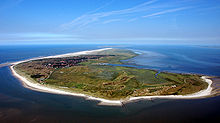Johanne (ship, 1854)
The Johanne was a wooden barque approx. 30 m long and approx. 5.5 m wide, which stranded and sank on its maiden voyage on November 6, 1854 off the East Frisian island of Spiekeroog with 216 emigrants on board. The accident was one of the triggers for the establishment of sea rescue stations on the German coast, which ultimately led to the establishment of the German Society for the Rescue of Shipwrecked People (DGzRS).
The ship
The Johanne was built at a shipyard in Lienen, today a district of Elsfleth , and put into service on October 21, 1854.
The ship's first voyage was to go from Bremen on the Weser to New York . 216 emigrants, including 94 men, 77 women, 32 children under 10 years of age and 13 infants, boarded as passengers on October 29 and 30. There were also 15 crew members and the master on board. The journey finally began on November 2, 1854.
The downfall
Bad weather prevented the ship from moving. Most of the passengers on board stayed below deck when the air was relatively narrow, the air was stuffy and there was no light. There were not bunks for all passengers; Luggage and belongings of the passengers were also stowed in the passenger decks. On the night of November 4th to 5th, the bad weather turned into a violent storm . While mooring the Bramsail a sailor went overboard who could not be rescued. Finally, on November 5, the ship lost the staysail in three bottom lakes . As a result , the ship ran aground off Spiekeroog three hours before the high tide occurred on November 6 and capsized to the sea side. Masts and rigging "came from above", partly cut at the command of the captain to prevent capsizing, partly due to the surf . A mast smashed a deckhouse and caused the first deaths and serious injuries. Other passengers were washed overboard by the boiling sea and drowned in the icy waters of the North Sea. The barque's lifeboats for rescuing passengers and crew were smashed and could no longer be used. The residents of the island of Spiekeroog had to watch the disaster helplessly because they did not have a suitable lifeboat on hand. Only when the tide was low could the shipwrecked be rescued. The islanders found dead bodies and battered body parts on the beach. The saved were lovingly welcomed and cared for by the even poor islanders until they left for Bremerhaven on November 14th, where they arrived on November 18th. Most of the survivors returned to their southern German homeland, poorer than ever, and only a few later tried a second attempt. As a result of the accident, 77 of the emigrants lost their lives, including 18 men, 34 women, 18 children under 10 years of age and 7 babies. The dead of Johanne were buried in the "Cemetery of the Drowned" (" Drinkeldodenkarkhoff ") on today's eastern edge of the village. The wreck gradually sank into the grinding sand . The recovered parts of the equipment were sold the following year. The ship's bell is kept in the Spiekeroog Island Museum.
consequences
The sinking of the Johanne led to a strong press coverage. Demands for the establishment of rescue stations were loud, but the knowledge decreased in the course of the time after the accident. But after the Hanoverian brig Alliance ran aground off Borkum on September 10, 1860 and there was again no possibility of rescuing the castaways, the press was outraged, as apparently no lessons had been learned from the sinking of the Johanne .
As a result, the first rescue stations were founded on the German North Sea coast , initially in 1861 the "Association for the Rescue of Shipwrecked People on the East Frisian Coast" by Georg Breusing in Emden . In 1863 the “Bremen Association for the Rescue of Shipwrecked People” followed by Adolph Bermpohl . On May 29, 1865, when there were already several rescue stations, the " German Society for Rescue of Shipwrecked People " was founded in Kiel as a national organization.
literature
- Christof Schramm: Heavy seas off Spiekeroog. Edition Beluga at mare, Mareverlag, Hamburg 2009, ISBN 978-3-86648-118-3 .
- Gotthard Fürer: The sinking of the three-masted barque Johanne. The fate of Hessian emigrants before Spiekeroog 1854 , 2nd edition, Verlag Enno Söker, Esens 2013, ISBN 978-3-941163-00-3


